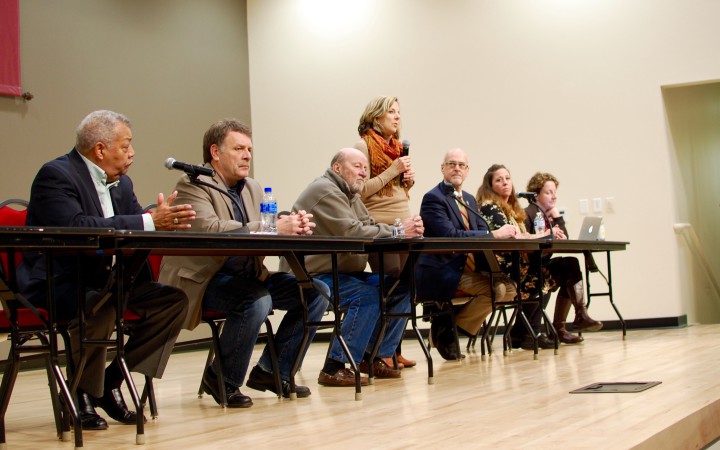In 2016, 17 million painkillers were prescribed in Buncombe County, a sum that amounts to about 68 pills for every person living in the county.
Opioids, a broad category of drugs that includes codeine, oxycodone, Vicodin, fentanyl and heroin, are at the center of a nationwide epidemic that counties across the U.S., including Buncombe, are scrambling to solve. Between 2014 and 2015, North Carolina was one of 20 states that witnessed an increase in the number of drug overdoses related specifically to opioids, rising almost 15 percent.
“We’re calling it an epidemic because the number of people who are dying, particularly from overdoses of opioids whether they be … prescribed by the doctor or bought on the street, that number continues to rise,” said Dr. Melissa Hoffman, a trauma surgeon with Mission Health and a fellow in hospice and palliative medicine at the Mountain Area Health Education Center.
Hoffman was the keynote speaker at a town hall organized by Buncombe County on Jan. 30 at A-B Tech about the dangers of opioid abuse. It marks an intensified effort to focus on the issue after the county Board of Commissioners voted in December to make opioid abuse one of its six strategic priorities.
“This affects the brain the way that nothing else can,” Commissioner Ellen Frost said at the town hall. “There’s no reason, there’s no logic. … No one wakes up in the morning and says, ‘I’m going to become a heroin addict.’ No one does that. We know that in Buncombe County you’re more likely to die from a heroin overdose than being hit by a car. We know that 80 percent of the folks that are addicted to heroin start off with a legal prescription.”
Prescription problems
The U.S. has 4.6 percent of the world’s population but uses 80 percent of the world’s opioid prescriptions, according to Hoffman. “So the question is why,” she said. “Why have doctors been prescribing like it’s going out of style, basically?”
Hoffman offered an explanation that was drawn in part from her personal experiences as a physician. In the 1990s, she said, pain became the fifth vital sign, measured alongside a patient’s heart rate, blood pressure, oxygen saturation and temperature. Doctors would ask patients to define their pain level on a scale from 1 to 10.
“So I think what ended up happening was patients have that expectation that doctors are going to treat their pain and that their pain level is going to be a 0,” Hoffman said. “So I’ll let you in on a secret: Doctors are human beings just like everyone else. I want people to like me, I want my patients to like me, I want people to be happy when they leave the office. So what ends up happening is we want to treat your pain, we want you to feel good and we want you to be a happy customer. So we prescribe more and more opioids.”
Hoffman also remembers being told during her training that if patients took these medications as prescribed, they would not become addicted.
“Unfortunately, we were completely wrong,” she said.

The roots of addiction
Addiction is a deeply ingrained neurological disease, Hoffman said. “It actually changes how the brain works, and it changes how the brain looks,” she said. “So when you look at images of people who are addicted, put them in an MRI machine, show them pictures of drugs, different portions of their brains light up.”
Once opioids enter the human body, they bind to receptors in the brain, spinal chord and gut. This prevents pain signals from reaching the brain and produces euphoria.
So why do some people become addicted and others don’t? “The problem is we don’t know, but we do know there are things that put people at risk,” Hoffman said.
Referencing a 2010 study, Hoffman said individuals who have experienced abuse, neglect or household dysfunction have a higher likelihood of developing addiction.
Hoffman said that in North Carolina, almost 50 percent of children up to age 17 have at least one adverse childhood experience and about 25 percent have at least two adverse childhood experiences. Those statistics are both higher than the national average.
Teenagers are also more at risk of becoming addicts. Hoffman said 90 percent of adults with substance abuse disorders started using drugs before they were 18 years old. “The teenage brain is often more reliant on impulse and emotions than on rational decision-making,” she said, “especially when it is under stress or under other influences like peer pressure.”
Even the youngest members of society are not out of the reach of opioid addiction. Hoffman said between 2004 and 2013, North Carolina saw a 604 percent increase in hospitalizations associated with drug withdrawals in newborns. In 2015, almost 400 babies born at Mission hospitals tested positive for substances.
“These mothers deserve our love and compassion and support,” Hoffman said. “Mark my words: No pregnant mom would ever be saying, one, I want to be addicted to heroin, and two, I want my child to be addicted to heroin, too.”
Stopping a killer
Opioid abuse has become entwined in many facets of society. “It’s in our doctor’s offices, it’s in our schools, it’s in our workplace, it’s in our homes, it’s in our families and it’s in our hearts,” Hoffman said.
From January to August 2017, there were 230 emergency room visits associated with opioid overdoses in Buncombe County, Hoffman said. That’s a jump from 84 visits during the same period in 2016.
But Hoffman offers some simple ways to start combating the problem. Parents talking to their kids about the dangers of prescription pills can be a helpful early way of staving off potential issues, she said.
People can also limit their exposure to prescription opioids by dropping off excess pills at designated drop-off locations. Locally, individuals can dispose of extra medication in the lobbies of the Buncombe County Sheriff’s Office, the Buncombe County Courthouse, the Asheville Police Department and at the Walgreens Pharmacy at 1835 Hendersonville Road.
As a means of limiting the amount of pills patients take home from the doctor’s office, North Carolina passed a law that went into effect at the beginning of this year. Called the STOP Act, the law states doctors can only prescribe five days of opioids for acute pain and seven days of opioids for post-surgical pain.
No matter what preventive measures are taken, however, Hoffman said one of the greatest barriers to treatment is stigma. “The negative public perceptions that surround addiction really make it difficult for individuals or their families to admit there is an issue or to reach out for help,” she said. “We know that addiction is not curable, but it is treatable. But the reality is if you don’t treat it, you have a high likelihood of dying of this disease.”




Before you comment
The comments section is here to provide a platform for civil dialogue on the issues we face together as a local community. Xpress is committed to offering this platform for all voices, but when the tone of the discussion gets nasty or strays off topic, we believe many people choose not to participate. Xpress editors are determined to moderate comments to ensure a constructive interchange is maintained. All comments judged not to be in keeping with the spirit of civil discourse will be removed and repeat violators will be banned. See here for our terms of service. Thank you for being part of this effort to promote respectful discussion.